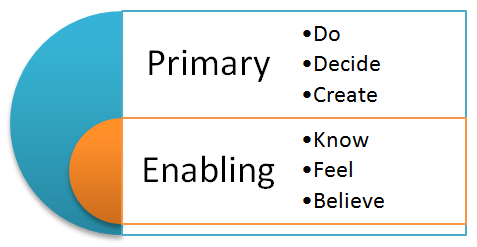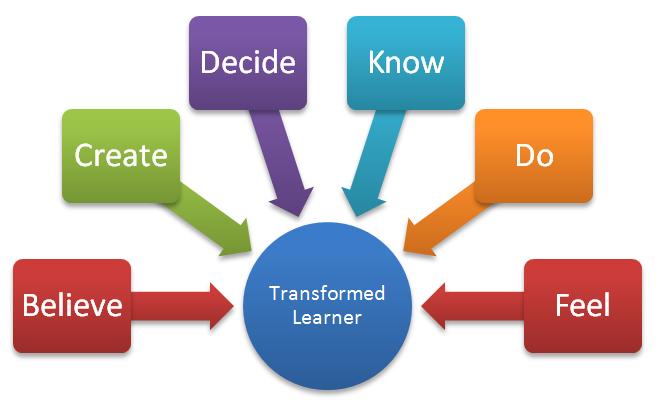This is a follow-up to the previous blog, Make Haste Slowly. See below.
In his book, E-learning by Design, William Horton presents a unique way to determine the objectives for a course or any training. Horton puts the main priority on objectives that have to do directly with job performance. He calls these three objective types the primary objectives because the main concern of a company is performance. Performance is, according to Horton, primarily related to what an employees can do, what they can create, and whether they make decisions that benefit the company or not.
Primary: do, decide, create
These objectives are in stark contrast to what you will find in most academic situations where the student will understand, appreciate, or identify. Nope, companies are not interested in understanding unless understanding contributes to being able to perform, to making good decisions, or to creating something that benefits the company.
This is why Horton provides three other objectives that he refers to as enabling objectives. Certainly to perform well on the job, knowing things is important but it is only important in light of how it affects job performance. Horton includes two other aspects that can hinder and help job performance—feelings and beliefs.

Enabling: know, feel, believe
Enabling just means that the training designer evaluates what the employee needs to know in order to perform his or her job better. Knowing that knives are sharp and can cause serious harm when used improperly can certainly help the employee decide to be careful and be sure to follow the proper procedures.
However, the employee may also have some fear of using the knife as well, either because he has experienced a knife cut or because he just does not feel confident to be able to do so without harming himself. In this case, an enabling objective would address the fear that is preventing proper use of a knife. Just adding to what the employee knows might help with some of that fear, but if the fear is preventing proper performance, then the fear will need to be addressed in the training. Similarly, a worker may underperform because of a belief. Perhaps the employee believes that he can do a better job by using the knife in a particular way that is against company policy, for example. Here the employer will need to address that belief in order to improve the employee’s performance.
In the business world, all training is only to improve job performance.
Because our training does involve more than just the Christian leader’s behavior for job performance, we would like to present a different way to think about these six objectives.
As Christians, I think that we all can resonate with the objectives that Horton so astutely lays out. As Christians, we are not only concerned with job performance. We are concerned about the whole man. We do care about a leader’s fears and joys. We do care about what a pastor believes, not just doctrinally but what he believes about his wife, his children, his congregation, about creation, about politics. We care about these because we know that these are fundamental aspects of our humanity that affect our outward behavior.
I love my neighbor as myself not because I took some training that taught me what the proper procedures are but because I love God. I love God, John says, because I know Him. I love God, John says, because He first loved me. Actually, the book of 1st John is an excellent mixture of what we know and what we do and how those interplay.
So I propose that we look at Horton’s objectives more as a mixture instead of primary and enabling.

All of the objective types feed into the primary objective of the transformed learner, who then brings that transformation to play in his or her community.
For our purposes here, suffice it to say that traditional education emphasizes knowledge. The primary goal or objective is to transfer a set of knowledge to the student. Academic institutions around the world are set up this way.
It is our desire to encourage course writers, educators and trainers of any sort to consider how all of the objective types can fit into the training that they are creating.
In order to accomplish this, course creators must be committed to assessing the learner and his or her situation. How can we address fear if we do not know what the learner is afraid of? How can we effectively address beliefs if we are American and our learner is Tamil? (See blog below, Make Haste Slowly, for an example.)
Learners always come from a specific situation. That situation includes his or her community in which he or she will be an agent of change. A realistic and accurate assessment of the learner’s situation and community will help guide the learner to live out in practical ways what he or she learns in the course/training.


Comments
reginamanley
14th December 2016 20:18pm
Several factors can subvert true kingdom transformation in the life of believers. Too much emphasis on the "do" and "decide," may result in people conforming outwardly but can disguise motivations or beliefs that have nothing to do with faith. An example comes from a missionary who discovered that the gospel was presented by Guatemalan Christians through a set of rules: Attend church, stop drinking and stop beating your wife. Good advice, but certainly not the gospel! Too much emphasis on "know" can result in a false pride about being a mature Christian. But when knowledge is not acted on, "doing," there will be no growth, no spiritual fruit and maturity is an illusion.
Horton's six areas makes learning wholistic. The six areas provide useful tools that encompass a wider range of issues including the intellect, actions, underlying attitudes and motives of the learners. All six areas become avenues to challenge the learner toward transformation at deeper levels than provided by the simpler know-be-do educational approach.
Send a Reply
Replies
Send a Reply